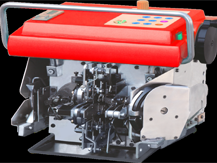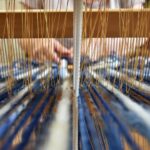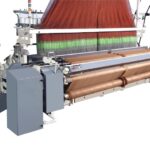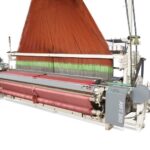The Beauty of Weaving - The Intertwining of Warp and Weft threads
The Beauty of Weaving - The Intertwining of Warp and Weft threads

The Art of Weaving
The art or craft of forming fabric or cloth by interlacing threads is the art of weaving. This art is one of the oldest existing methods in the world. The traditional and natural process of hand-weaving and using looms are slowly and gradually taking an advanced shape with the new development of machines in the textile industry. The art can be traced back to the Neolithic age, an approximate 12,000 years ago, when the basic technique of weaving was applied to intertwine branches and twigs to build fences, shelters and baskets for protection.
Weaving, in the early ages, was known as a women’s craft. Women who stayed at home to look after their houses and children used to start spinning and weaving yarns, whenever they could. A distaff is a tool used to hold the bundle of fibres, such as flax or wool. Spinning was a simple and everyday activity performed by women, due to which the distaff became the emblem of women’s work or domain in the family.
In Greek mythology, weaving is sometimes believed to be the centre of creation; as symbolized by the Fates or Moirai, a group of three weaving goddesses who assign individuals the destinies at their birth. Their names are Clotho (the Spinner- who spins us into being), Lachesis (the Assigner – who weaves our fate) and Atropos (the Inflexible- who cuts the thread of our lives). These Fates or Moirai represented the cycle of life, that especially stood for Birth, Life and Death.
Warp and Weft in Weaving
Weaving is a craft where we see two threads, warp and weft, intertwining and embracing each other in a beautiful romance to result in fabric or cloth. In the process of weaving, warp threads are strung vertically over the loom, providing the foundation for weaving, and the weft threads run up and down around the warp threads to create the design. All types of weaving involve warp threads and weft threads.
A most common weaving method is the simple weave, in which the weft yarn goes alternately above and below the warp yarn and creates a flat surface that allows the patterns to get easily printed. Other two types are Basket weaving and Twill weaving, where one has a checkerboard pattern, and the other builds a strong, heavy, denim-like fabric.
“To produce the textile, these two threads must be bound, otherwise, each will remain fragile and fluttering potentiality…if the meeting of opposites does not take place, nothing is created, for each element is defined by its opposite and takes its meaning from it.” (ZATI- The Art of Weaving a Life).
The way these yarns go crossing and come out to form a fabric- symbolizes relationships we build and hold in this world. Nothing is created without weaving– be it motherhood, fatherhood, childhood, sisterhood, brotherhood, friendship, or a love relationship.






